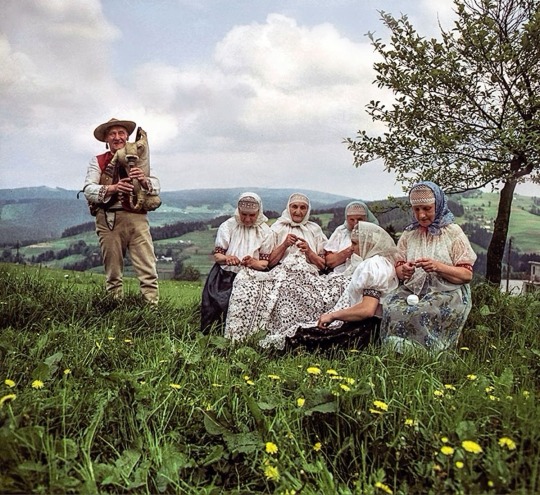#Woody Ochnio/Forum
Text

The lacemakers of Koniaków, a circle of village matrons at work in the mountains, with a view of the Beskid range in the background, and a mountaineer from the Beskid Żywiecki region playing the bagpipes, 1977.
Photo.: Woody Ochnio/Forum
Koniaków, a village in the Beskid mountain range in the South-West of Poland is the home of a regional speciality nowadays famous the world over. The items of crocheted lace incite the awe of ethnographers, who call them a "world represented through talented hands”. The skilled crochet hook operators apply their imagination and sense of beauty and choose from a series of some 2200 patterns to convey the world that surrounds them. Gąsiorki (duckies), strupki (crusties), skrzydełka (little wings), kaczeńce (buttercups), and niezapominajki (forget-me-nots) - these are all names of the various stiches that build up whole works of art, both big and small. There are delicate and ornate napkins, crocheted coifs, white and creamy little round roses, liturgical lace, and caps. There are also items dictated by fashion and the market’s needs - collars, gloves, cupboard covers, wedding gowns, as well as earrings, cuff links, lampshades and screens.
The Koniaków village is situated right by the meeting point of Poland’s borders with the Czech Republic and Slovakia. The local artists, all of whom are women, reiterate that without crocheting, there would be no life. Their workshop is contained within a kiśnicka, a little wooden box which keeps the essential items passed on through generations of lace makers. Inside, there is a crochet hook, as well as thread, ready decorative motifs, and the one thing that is most important to the crocheters - eye glasses. All the remaining gear - that is, thousands of crochet patterns, traditional motifs and compositions are all contained in the artisan’s minds and imaginations.
The folk artists are constantly searching for ways in which to adapt traditional ornamentation to fashionable, contemporary forms. This search once resulted in the creation of crocheted lace g-strings, an item which proved controversial as it divided the community. In a talk with Culture.pl, Barbara Juroszek, from the Regional Cultural Centre, commented.
Some said that it’s a disgrace that the same lace that decorated altars and stoles would now decorate… well, something else. Others set themselves to work, creating a collection of women’s and men’s underwear, and the whole scandal basically won this local speciality some major publicity.
Another famous moment came with a 5-metre spread, which made it to the Guinness Book of Records. It took more than 5 months to make, weighed 5kg and used up 50 kilometres of thread. The thousands of elements which were joined together were later presented at the International Crochet Festival in Lepoglava, Croatia. Today's lace experts also shows no hesitation when pointing to the most talented and innovative crochet maker of modern times. It’s Beata Legierska, who has raised heklowanie to the height of high art, and has no equals when it comes to the meticulous precision of her work. She has been creating crochet laces from the age of 6, and has two generations of lacemakers behind her. Beata Legierska has also presented her work at a great many exhibitions in the Czech Republic, Germany, France, Romania and Switzerland.
Source: The World in Talented Hands: Koniaków Crocheted Lace on CULTURE.PL
#Koniaków#Poland#ancestors alive!#what is remembered lives#memory & spirit of place#ancient ways#folkways#love#life#traditions#past times#Beskid Żywiecki#Woody Ochnio/Forum#Photograph#1977#lace#crochet#lace makers#folk artists#The World in Talented Hands: Koniaków Crocheted Lace#CULTURE.PL
1 note
·
View note